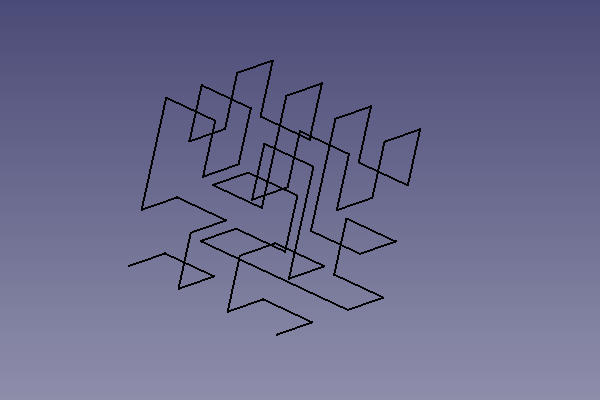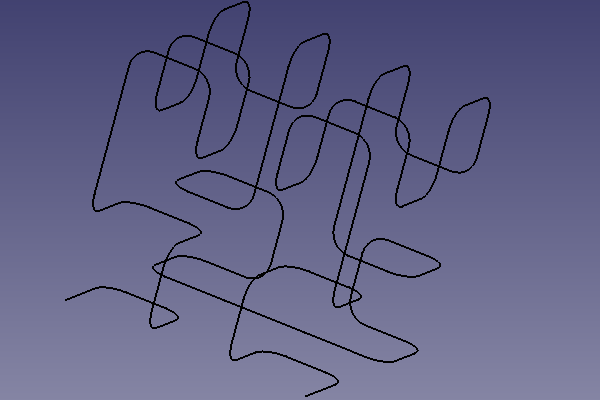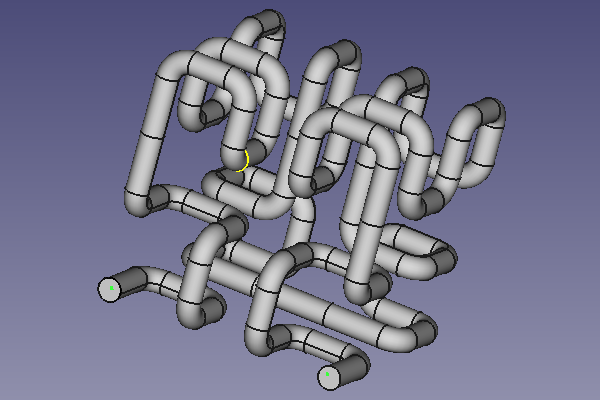Macro HilbertCurve/fr
| Description |
|---|
| Cette macro crée une courbe de Hilbert en 2 ou 3 dimensions avec de nombreuses itérations. Version macro : 1.2.0 Date dernière modification : 2021-02-13 Version FreeCAD : 0.16 to 0.19 Téléchargement : Icône de la barre d'outils Auteur: Simone Bignetti |
| Auteur |
| Simone Bignetti |
| Téléchargement |
| Icône de la barre d'outils |
| Liens |
| Page des macros Comment installer une macro Comment créer une barre d'outils |
| Version Macro |
| 1.2.0 |
| Dernière modification |
| 2021-02-13 |
| Version(s) FreeCAD |
| 0.16 to 0.19 |
| Raccourci clavier |
| None |
| Voir aussi |
| None |
Description
Cette macro crée une courbe de Hilbert en 2 ou 3 dimensions avec de nombreuses itérations.
Utilisation
- Démarrez la macro dans un document FreeCAD.
- Dans la boîte de dialogue qui s'ouvre, choisissez les paramètres de la courbe de Hilbert:
- Cliquez sur OK pour créer le fil ou sur CANCEL pour quitter la macro.

Vous pouvez utiliser une courbe de Hilbert comme chemin pour un Part Balayage, mais il est préférable d'appliquer d'abord un rayon au fil, sinon le balayage sera mal formé.

.
Trouver le bon rayon peut nécessiter des tests. Cela dépend de la longueur des segments de courbe et de la forme du profil à balayer.

.
Script
Macro_HilbertCurve.FCMacro
# -*- coding: utf-8 -*-
# Copyright (c) 2020 Simone Bignetti, Gottolengo Italy (simone.b)
#
# This file is part of the FreeCAD CAx development system.
#
# This library is free software; you can redistribute it and/or
# modify it under the terms of the GNU Lesser General Public
# License as published by the Free Software Foundation; either
# version 2.1 of the License, or (at your option) any later version.
#
# This library is distributed in the hope that it will be useful,
# but WITHOUT ANY WARRANTY; without even the implied warranty of
# MERCHANTABILITY or FITNESS FOR A PARTICULAR PURPOSE. See the GNU
# Lesser General Public License for more details.
#
# You should have received a copy of the GNU Lesser General Public
# License along with this library; if not, write to the Free Software
# Foundation, Inc., 51 Franklin Street, Fifth Floor, Boston, MA 02110-1301
# USA
#
# You can contact me by mail at simone.bignetti@linux.it
__Name__ = 'HilbertCurve'
__Comment__ = 'This macro creates an Hilbert curve wire in 2 or 3 dimensions with many iterations.'
__Author__ = 'Simone Bignetti'
__Version__ = '1.2.0'
__Date__ = '2020-12-29'
__License__ = 'GNU LESSER GENERAL PUBLIC LICENSE Version 2.1, February 1999'
__Web__ = 'https://wiki.freecad.org/Macro_HilbertCurve'
__Wiki__ = 'https://wiki.freecad.org/Macro_HilbertCurve'
__Icon__ = 'https://wiki.freecad.org/images/6/69/Hilbert_curve_icon.png'
__Help__ = 'Choose the dimensions of the wire, the number of the iterations and the length of the wire segment.'
__Status__ = 'Stable'
__Requires__ = ''
__Communication__ = 'https://forum.freecad.org/viewtopic.php?f=22&t=53781'
__Files__ = 'HilbertCurve.svg'
# For the wire
import FreeCAD as app
import Draft
# For the gui
from PySide import QtGui, QtCore
class HilbertCurve:
"""The class of the Hilbert curve.
By this class it's possible to create a wire
of a fractal Hilbert curve with
a fixed number of dimensions and iterations.
"""
def __init__(self, dimensions, iterations):
"""Initialize the Hilbert curve.
Args:
iterations (int): iterations to use in constructing the curve
dimensions (int): number of dimensions
"""
self.dimensions = dimensions
self.iterations = iterations
# minimum and maximum distance along curve
self.min_distance = 0
self.max_distance = 2 ** (self.iterations * self.dimensions) - 1
# minimum and maximum coordinate value in any dimension
self.min_coordinate = 0
self.max_coordinate = 2 ** self.iterations - 1
# number of points
self.number_of_points = 2 ** (self.iterations * self.dimensions)
def point_from_distance(self, distance):
"""Return a point in n-dimensional space given a distance along a the curve.
Args:
distance (int): integer distance along the curve
Returns:
point (iterable of ints): an n-dimensional vector of length dimensions where
each component value is between 0 and 2**iterations-1.
"""
bit_string = format(distance, 'b').zfill(self.iterations * self.dimensions) # zero filled binary distance
point = [int(bit_string[i::self.dimensions], 2) for i in range(self.dimensions)] # transpose of distance
# Gray decode: point = point xor (point / 2)
gray = point[self.dimensions-1] >> 1
for i in range(self.dimensions-1, 0, -1):
point[i] ^= point[i-1]
point[0] ^= gray
# Undo excess work
q = 2
while q != (2 << (self.iterations-1)):
p = q - 1
for i in range(self.dimensions-1, -1, -1):
if point[i] & q:
# invert
point[0] ^= p
else:
# exchange
gray = (point[0] ^ point[i]) & p
point[0] ^= gray
point[i] ^= gray
q <<= 1
return point
def get_min_distance(self):
"""Return the minimum distance along the curve."""
return self.min_distance
def get_max_distance(self):
"""Return the maximum distance along the curve."""
return self.max_distance
def get_min_coordinate(self):
"""Return the minimum coordinate value in any dimension."""
return self.min_coordinate
def get_max_coordinate(self):
"""Return the maximum coordinate value in any dimension."""
return self.max_coordinate
def get_number_of_points(self):
"""Return the number of points in the curve."""
return self.number_of_points
def get_points(self):
"""Return the list of points in the curve."""
points = []
for point_number in range(self.number_of_points):
points.append(self.point_from_distance(point_number))
return points
def __str__(self):
return f"HilbertCurve(dimensions={self.dimensions}, iterations={self.iterations})"
def __repr__(self):
return self.__str__()
class Hilbert_Dialog(QtGui.QDialog):
"""The dialog for the Hilbert curve
This class opens in FreeCAD a dialog to input
the number of dimensions and the number of iterations
to create the Hilbert curve.
OK creates the curve.
CANCEL quit the macro.
"""
def __init__(self):
super(Hilbert_Dialog, self).__init__()
self.setupUi()
def setupUi(self):
self.dimensions = 2
self.iterations = 3
self.setGeometry(250, 250, 400, 300) # Window definition
self.setWindowTitle("Hilbert curve Macro")
titleLabel = QtGui.QLabel("Create an Hilbert curve in two or three dimensions") # Title and subtitle
titleFont = QtGui.QFont()
titleFont.setBold(True)
titleFont.setWeight(75)
titleLabel.setFont(titleFont)
subtitleLabel = QtGui.QLabel("This macro creates a wire in the draft workbench\nwith the shape of an Hilbert curve in two or three dimensions.\nFor example, you can use this wire as a sweep path.\nIt's recommended to apply a radius at the wire,\nin order to obtain a correct sweep generation.")
titleBox = QtGui.QVBoxLayout()
titleBox.addWidget(titleLabel)
titleBox.addWidget(subtitleLabel)
titleBox.insertStretch(-1)
dimensionsLabel = QtGui.QLabel("Number of dimensions: ") # Number of dimensions
self.twoDradioButton = QtGui.QRadioButton()
self.twoDradioButton.setText("2D")
self.twoDradioButton.setChecked(True)
self.threeDradioButton = QtGui.QRadioButton()
self.threeDradioButton.setText("3D")
dimensionsBox=QtGui.QHBoxLayout()
dimensionsBox.addWidget(dimensionsLabel)
dimensionsBox.addWidget(self.twoDradioButton)
dimensionsBox.addWidget(self.threeDradioButton)
iterationsLabel = QtGui.QLabel("Iterations:") # Iterations and length spins in a grid
self.iterationsSpin = QtGui.QSpinBox()
self.iterationsSpin.setMinimum(1)
self.iterationsSpin.setMaximum(10)
lengthLabel = QtGui.QLabel("Length:")
self.lengthSpin = QtGui.QDoubleSpinBox()
self.lengthSpin.setMinimum(1.0)
self.lengthSpin.setMaximum(999999.000000000000000)
self.lengthSpin.setValue(10.000000000000000)
grid = QtGui.QGridLayout()
grid.setSpacing(10)
grid.addWidget(iterationsLabel, 1, 0)
grid.addWidget(self.iterationsSpin, 1, 1)
grid.addWidget(lengthLabel, 2, 0)
grid.addWidget(self.lengthSpin, 2, 1)
okButton = QtGui.QPushButton("OK") # Ok and Cancel Buttons at right bottom
okButton.clicked.connect(self.onOkButton)
cancelButton = QtGui.QPushButton("Cancel")
cancelButton.clicked.connect(self.onCancelButton)
buttonBox = QtGui.QHBoxLayout()
buttonBox.addStretch()
buttonBox.addWidget(okButton)
buttonBox.addWidget(cancelButton)
vbox = QtGui.QVBoxLayout()
vbox.addLayout(titleBox)
vbox.addLayout(dimensionsBox)
vbox.addLayout(grid)
vbox.addLayout(buttonBox)
vbox.setSpacing(30)
vbox.insertStretch(1)
self.setLayout(vbox)
self.show()
def onOkButton(self):
if self.twoDradioButton.isChecked():
dimensions = 2
else:
dimensions = 3
iterations = self.iterationsSpin.value()
length = self.lengthSpin.value()
HC=HilbertCurve(dimensions, iterations)
points = HC.get_points()
pl = app.Placement()
pl.Rotation.Q = (0.0, 0.0, 0.0, 1.0)
pl.Base = app.Vector(0.0, 0.0, 0.0)
vectors = []
if dimensions == 2:
for point in points:
vectors.append(app.Vector(point[0]*length, point[1]*length, 0.0))
else:
for point in points:
vectors.append(app.Vector(point[0]*length, point[1]*length, point[2]*length))
wire = Draft.makeWire(vectors, placement=pl, closed=False, face=False, support=None)
wire.Label = "Hilbert"
Draft.autogroup(wire)
self.close()
def onCancelButton(self):
self.close()
hilbert_dialog = Hilbert_Dialog()
hilbert_dialog.exec()